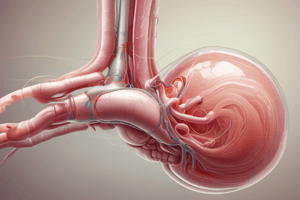Podcast
Questions and Answers
Match the following anatomical structures with their functions in the renal system:
Match the following anatomical structures with their functions in the renal system:
Nephrons = Functional units responsible for filtering the blood and producing urine Glomerular membrane = Allows filtration of plasma while preventing large molecules from passing through Juxtaglomerular apparatus = Regulates blood pressure and the filtration rate of the glomerulus Urinary bladder = Temporary storage reservoir for urine before it is excreted from the body
Match the following renal processes with their descriptions:
Match the following renal processes with their descriptions:
Filtration = Removal of waste products and excess substances from the blood Reabsorption = Reclaiming useful substances such as water, glucose, and amino acids Renal blood flow = Volume of blood that passes through the kidneys per minute Regulation of water & electrolyte balance = Maintaining the body's fluid and ion levels within narrow limits
Match the following waste products with their sources in protein metabolism:
Match the following waste products with their sources in protein metabolism:
Urea = From protein breakdown Uric acid = From nucleic acid breakdown Creatinine = From muscle creatine breakdown End products of hemoglobin breakdown = From breakdown of red blood cells
Match the following functions of the renal system with their descriptions:
Match the following functions of the renal system with their descriptions:
Which of the following is NOT one of the chief functions of the renal system?
Which of the following is NOT one of the chief functions of the renal system?
Match the following anatomical terms with their descriptions in the urinary system:
Match the following anatomical terms with their descriptions in the urinary system:
What is the size of each kidney in adults?
What is the size of each kidney in adults?
How is urine delivered to the urinary bladder?
How is urine delivered to the urinary bladder?
Which anatomical structure is responsible for the filtration of plasma in the kidneys?
Which anatomical structure is responsible for the filtration of plasma in the kidneys?
What is the function of erythropoietin in the renal system?
What is the function of erythropoietin in the renal system?
Which of the following is NOT one of the chief functions of the renal system?
Which of the following is NOT one of the chief functions of the renal system?
What is the approximate weight of each kidney in adults?
What is the approximate weight of each kidney in adults?
Which anatomical structure in the kidney is responsible for the filtration of plasma?
Which anatomical structure in the kidney is responsible for the filtration of plasma?
What are the two chief functions of the renal system related to electrolyte balance?
What are the two chief functions of the renal system related to electrolyte balance?
Which hormone is associated with the endocrine function of the renal system?
Which hormone is associated with the endocrine function of the renal system?
Flashcards are hidden until you start studying
Study Notes
Renal System Functions and Structures
- The renal system is responsible for filtering blood, regulating fluid and electrolyte balance, and disposing of waste products.
- Two chief functions regarding electrolyte balance include maintaining sodium and potassium levels in the body.
- Erythropoietin, produced by the kidneys, stimulates the production of red blood cells in response to low oxygen levels.
- Each kidney in adults is about the size of a fist, typically measuring around 10-12 cm in length.
- Each kidney weighs approximately 125-170 grams in adults.
Urine Formation and Delivery
- Urine is delivered to the urinary bladder via ureters, which transport urine through peristaltic movements.
- The nephron is the anatomical structure responsible for the filtration of plasma in the kidneys, consisting of the glomerulus and renal tubules.
Waste Products of Protein Metabolism
- Common waste products generated from protein metabolism include urea, creatinine, and uric acid, all of which are excreted by kidneys.
Functions of the Renal System
- The chief functions of the renal system encompass waste removal, electrolyte balance regulation, and acid-base balance maintenance.
- One function that is NOT a chief function of the renal system is the production of digestive enzymes.
Urinary System Anatomical Terms
- The urinary system includes structures such as the kidneys (filtration), ureters (transport), bladder (storage), and urethra (excretion).
Studying That Suits You
Use AI to generate personalized quizzes and flashcards to suit your learning preferences.




